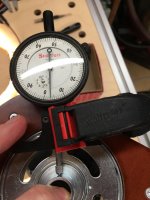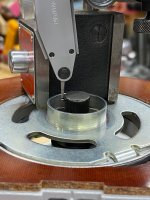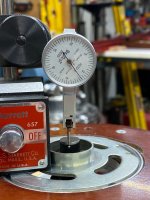Mike Goetzke
Member
- Joined
- Jul 12, 2008
- Messages
- 1,183
Mine is off center but like many have mentioned (and shown) even if perfectly centered there is plenty of play with the snap-in bushing holder. I saw a video where a guy showed how to make a perfectly centered bushing holder for another brand router but should work for the 1400.
He used a transfer punch to accurately layout the holes in the base and then he used a small drill like bit in the router to punch the center hole. (There are several other steps but these are the key ones to center the bit.) Just surprises me with so many of these 1400's out there some company hasn't offered a bushing base for this router.
He used a transfer punch to accurately layout the holes in the base and then he used a small drill like bit in the router to punch the center hole. (There are several other steps but these are the key ones to center the bit.) Just surprises me with so many of these 1400's out there some company hasn't offered a bushing base for this router.






